If you’ve seen your cat tear up your favorite couch, you know the pain. Scratching isn’t just a quirky habit; it’s in their DNA. The good news? You don’t have to live with shredded furniture.
You can train your cat to use a scratching post—yes, even that stubborn one who ignores you half the time.
I’ve been there too. My cat once transformed my dining chairs into frayed art pieces. After trying cheap posts and weak methods, I found what truly works.
Let me guide you through the process to save your sanity and your furniture.
Why Cats Scratch in the First Place
Ever wondered why cats scratch in the most inconvenient places? It’s not because they enjoy watching you panic. Cats scratch to:
- Sharpen their claws and keep them healthy.
- Stretch their bodies after a good nap.
- Mark their territory with scent glands in their paws.
- Relieve stress or boredom (yes, your cat has stress too).
Once you understand that scratching is natural, you stop seeing it as “bad behavior” and start looking for ways to redirect it. Because spoiler alert: you can’t stop them from scratching, but you can teach them where to do it.
Choosing the Right Scratching Post
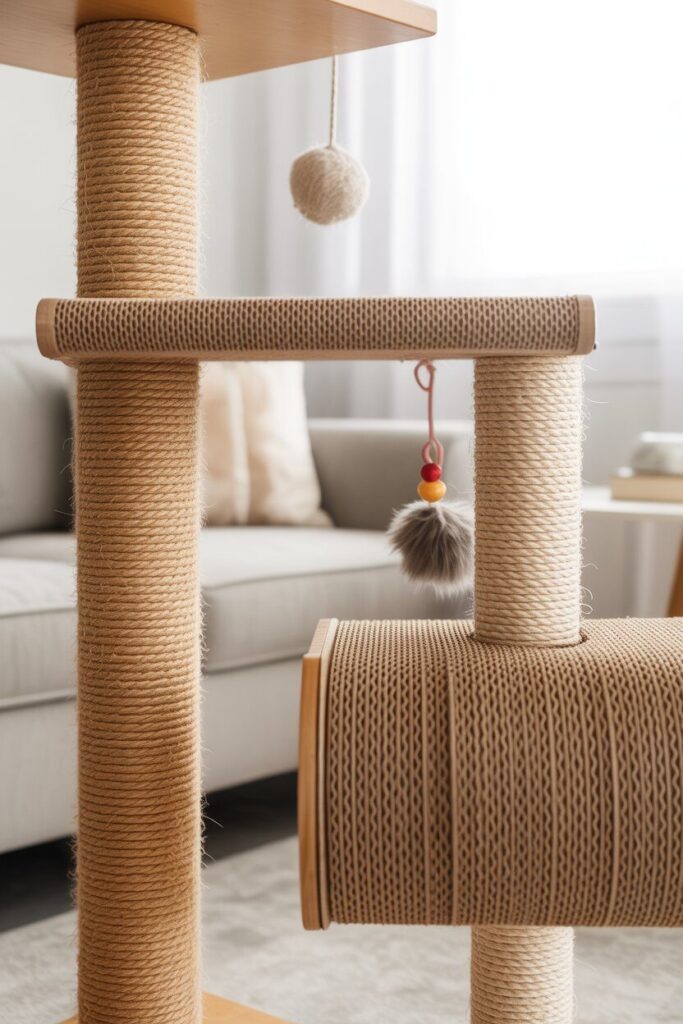
Not all scratching posts are created equal. In fact, some are so flimsy they might as well come with a label that says “for decoration only.” If you want your cat to actually use it, here’s what to look for.
Height Matters
Cats love a good full-body stretch. A scratching post should be tall enough for your cat to stretch out completely. Think at least 30 inches for most adult cats. If it’s shorter, they’ll ignore it.
Sturdiness Is Key
A post that wobbles is a post that fails. Cats hate unstable surfaces. Look for something with a wide, heavy base. Trust me, a falling post equals instant rejection.
Material Choices
Cats are picky. Some prefer sisal rope, others go for carpet, and some even like cardboard. IMO, sisal wins most of the time because it’s durable and satisfying to claw into. But hey, every cat is a critic.
Variety Works
Don’t limit yourself to one post. Mix it up with:
- Vertical posts
- Horizontal scratchers
- Inclined boards
Your cat might surprise you with their preferences.
Check these top-rated scratching posts available now on Amazon
Placement: Location Is Everything
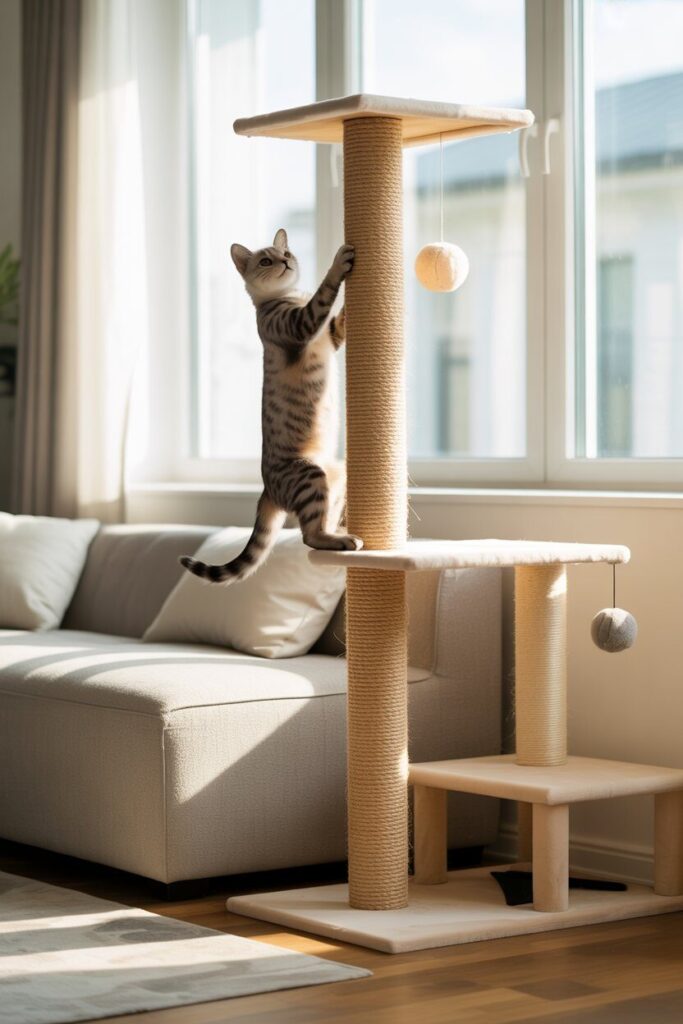
Here’s the part many cat owners get wrong. You can buy the fanciest post in the world, but if you shove it in a corner of the basement, your cat will still choose your couch.
Put the post where your cat already scratches or hangs out. That usually means near furniture, doorways, or windows.
Cats like to mark areas they consider important. And yes, it might clash with your décor, but would you rather have a stylish living room or a shredded sofa?
Pro tip: Try placing multiple posts in different rooms. You don’t drink coffee only in the kitchen, right? Well, cats don’t scratch in just one spot either.
How to Introduce Your Cat to the Scratching Post
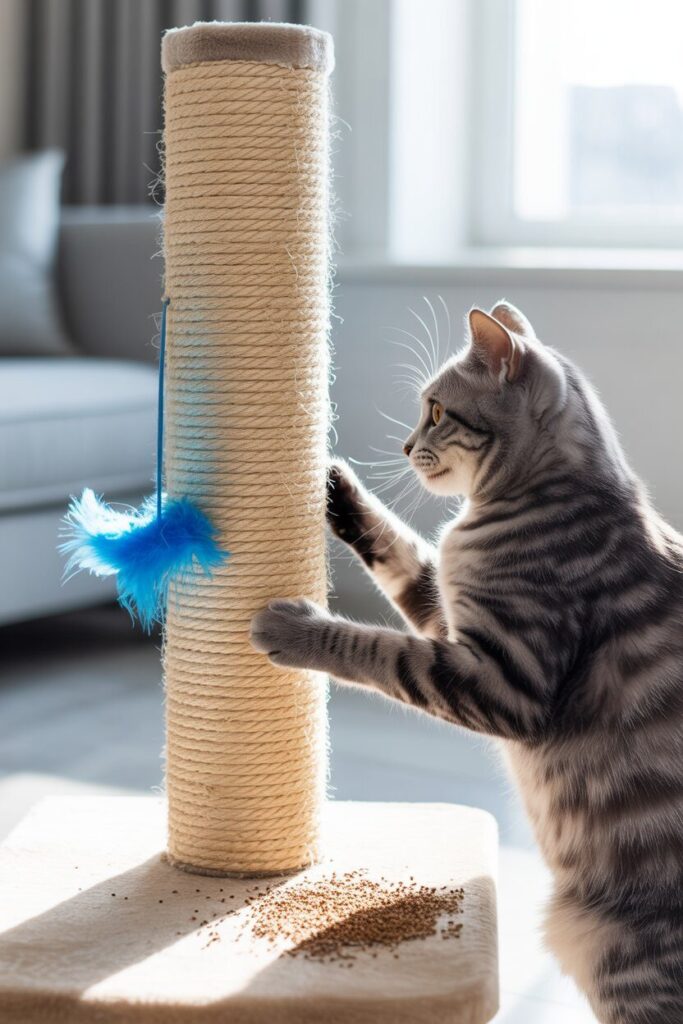
Okay, so you’ve bought the perfect post and placed it wisely. Now comes the fun part: convincing your cat to actually use it.
Make It Enticing
Cats need a reason to check it out. Try:
- Rubbing catnip into the post.
- Spraying cat-attractant spray.
- Dangling toys around it.
Basically, make the post the hottest new hangout spot in your house.
Positive Reinforcement
Every time your cat uses the post, reward them. Treats, petting, verbal praise—whatever makes them happy. The goal is to make scratching the post feel like hitting the jackpot.
Redirect, Don’t Scold
Caught your cat scratching the couch? Gently redirect them to the post. Don’t yell. Cats don’t respond to lectures (and honestly, do humans either?). Just move them over, encourage them, and reward them if they scratch the post.
Lead by Example
It might sound silly, but scratching the post yourself can spark curiosity. I’ve literally dragged my fingers across a post to show my cat, and yes, it worked.
Shop the best scratching posts for cats today on Amazon
Training Tricks That Actually Work
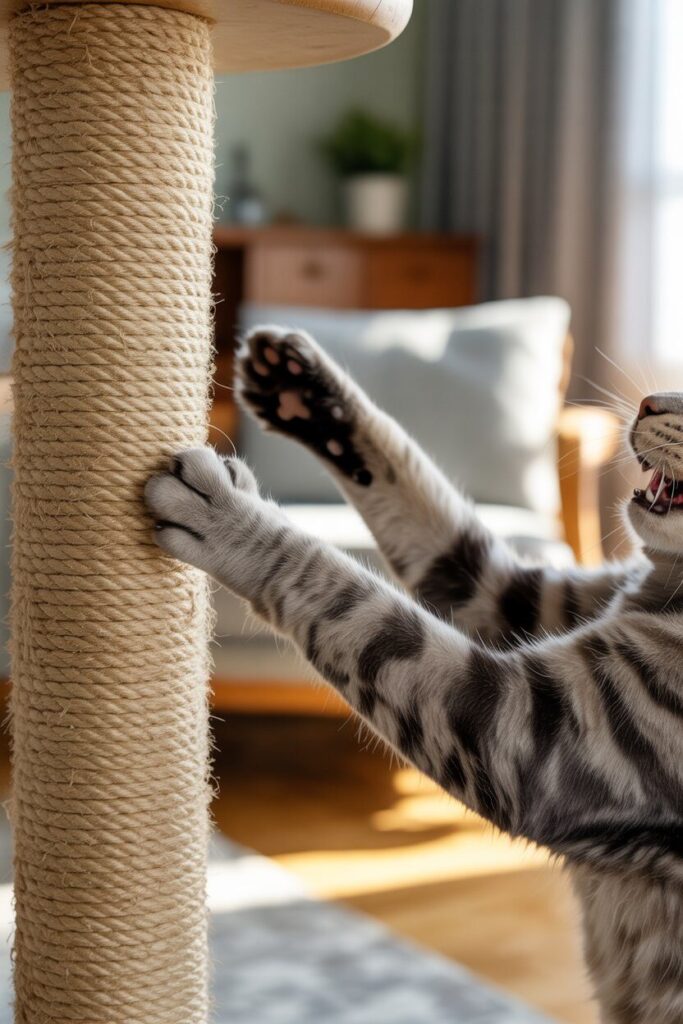
Still struggling? Let’s step up the game.
Use Deterrents on Furniture
Make your furniture less appealing with:
- Double-sided tape (cats hate sticky paws).
- Furniture covers or throws.
- Pet-safe sprays that discourage scratching.
At the same time, keep the post close by as a more attractive option.
Play Near the Post
Cats often scratch before or after play. Use a wand toy to get them bouncing around the post. Once the game ends, they’ll likely scratch it.
Scratch at the Right Time
Notice when your cat naturally scratches (after naps, after eating, or during zoomies). Place the post in their path at those moments to catch their attention.
Common Mistakes to Avoid
Sometimes we sabotage ourselves without realizing it. Here are mistakes you want to dodge:
- Buying posts too small or flimsy. Your cat won’t respect them.
- Using the post as punishment. Forcing them never works.
- Moving the post constantly. Cats like consistency.
- Expecting instant results. Some cats warm up slowly.
Patience is your best friend here. Think of it like convincing someone to switch coffee brands—it won’t happen overnight.
When One Post Isn’t Enough
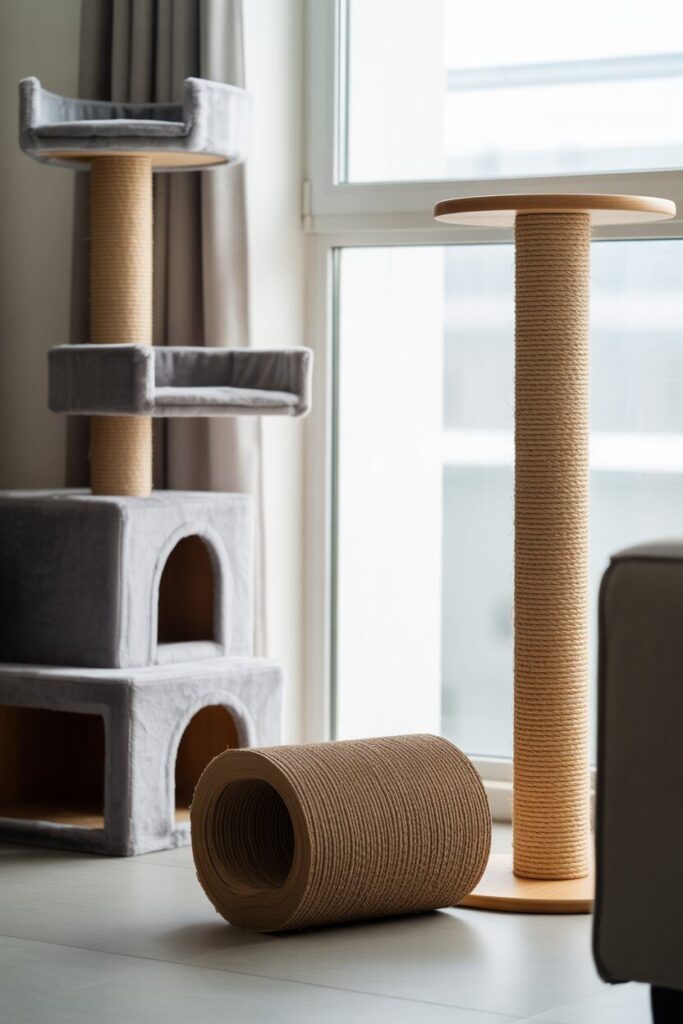
If your cat ignores the post you bought, don’t assume they hate all posts. Sometimes it’s just the wrong style.
Experiment with:
- A tall tower for climbers.
- A flat scratcher for ground-level scratchers.
- A cat tree with built-in posts for multipurpose fun.
I once thought my cat would love a tall post, but turns out he was a horizontal scratcher at heart. Lesson learned: give them options.
Discover highly recommended scratching posts your cat will love on Amazon
Making Scratching Part of Their Routine
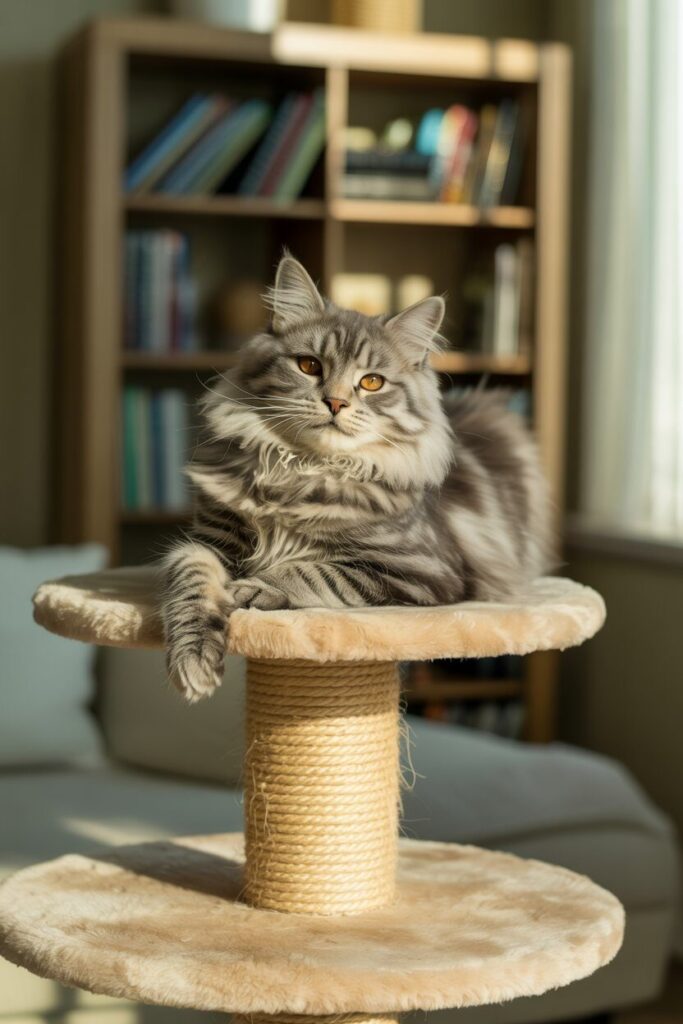
The goal isn’t just to stop destructive scratching; it’s to make the scratching post part of your cat’s daily life.
- Consistency matters. Keep the post in the same spot.
- Routine helps. Reward them at the same times each day when they scratch.
- Encouragement goes a long way. Don’t just assume they’ll stick with it. Keep reinforcing the behavior.
Over time, your cat will head straight to the post like it’s second nature. And your furniture will thank you.
My Personal Experience with Training
Let me be honest: my first attempt at training was a flop. I bought a cheap carpet post, shoved it in the corner, and wondered why my cat ignored it. Meanwhile, my poor armchair was suffering a slow death.
When I finally invested in a tall, sturdy sisal post and put it right next to the couch, magic happened.
I added some catnip, played around it, and rewarded every scratch. Within a week, my cat switched loyalties. It wasn’t instant, but it was worth it.
Now, instead of panicking every time I hear claws in the living room, I can relax. The scratching post takes the damage, and my furniture looks normal again.
Conclusion
Training your cat to use a scratching post easily isn’t rocket science. It’s all about understanding why they scratch, picking the right post, placing it smartly, and reinforcing the behavior with patience.
Sure, it takes a little trial and error, but once you figure it out, you’ll save your furniture and keep your cat happy.
So don’t give up if your first post flops. Try different styles, experiment with placement, and keep rewarding good behavior. Before you know it, you’ll watch your cat scratch their post with pride instead of despair.
And hey, you’ll finally win back your couch—consider it a small but glorious victory.
How Long Does It Take to Train a Cat to Use a Scratching Post?
Training time depends on your cat’s personality and your consistency. Some cats adapt in a week, while others may need a few weeks. Cats that enjoy scratching surfaces usually adjust faster.
Be patient and consistent. Use positive reinforcement when your cat scratches the post. If you consistently reward and redirect, your cat will prefer the post over your furniture.
Why Does My Cat Prefer the Couch Over the Scratching Post?
Cats love couches because they are sturdy, tall, and smell like you. This makes them great for scratching. If the scratching post is small, flimsy, or out of sight, your cat might ignore it.
The solution is to provide a better option. Place a tall, sturdy post near the couch. Add catnip or toys, and reward your cat for using the post.
Over time, the couch will seem less appealing compared to the fun of scratching the post.
What Is the Best Material for a Scratching Post?
Most cats enjoy sisal rope or fabric. It has a rough, durable texture that feels natural for clawing. Sisal stands up to repeated scratching without wearing down quickly.
But some cats like carpet or cardboard scratchers more. If your cat ignores a sisal post, try different materials. Offering a variety usually works best.
Should I Punish My Cat for Scratching Furniture?
Punishment rarely helps with cats and can worsen the issue. Cats don’t grasp scolding or yelling, and negative responses can cause stress or anxiety.
Instead, redirect their behavior. Gently guide your cat to the scratching post and reward them when they use it. This method shows your cat where it’s okay to scratch, strengthening your bond.
How Many Scratching Posts Should I Have in My House?
You should have at least one scratching post for each cat, plus a few extras around the house. Cats enjoy scratching in different spots, especially near their resting, eating, or viewing areas.
Having multiple posts means your cat will always have a nearby option. This helps prevent them from scratching your furniture out of convenience. It’s like providing scratching stations in every key part of their territory.
